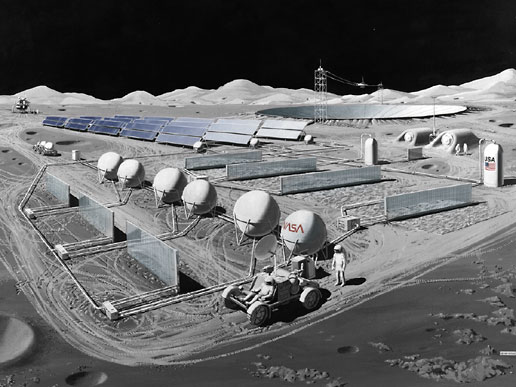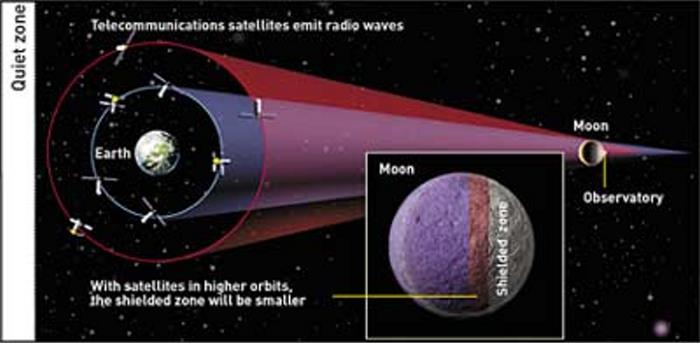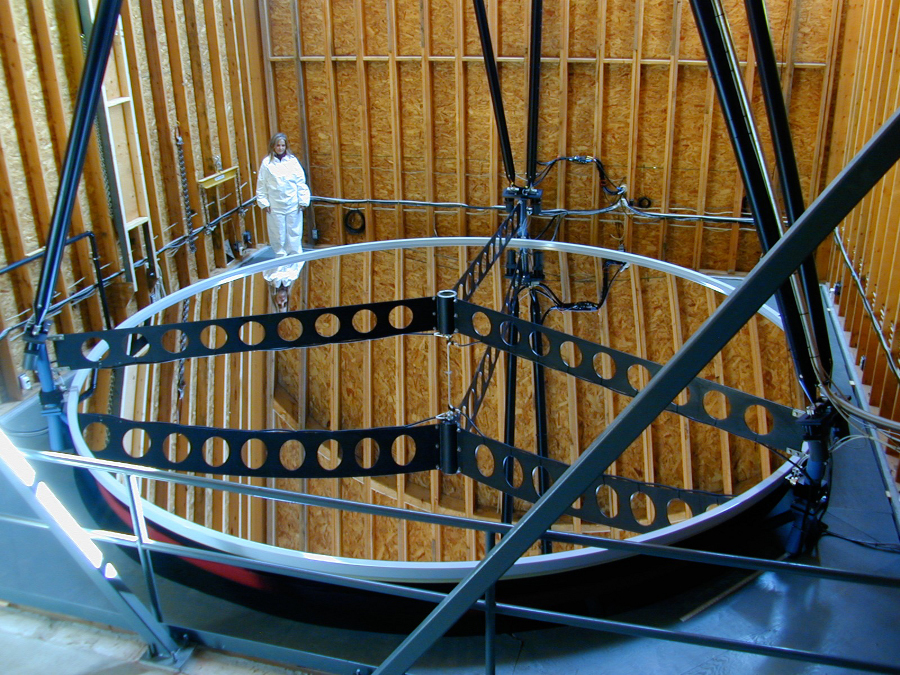|
|
||
|
..
Looking back in time from the
Moon
The Moon could become an orbiting observatory, allowing astronomers to peer back in time further than ever before. Nasa experts say that our natural satellite could house a powerful optical telescope with a liquid mirror - yes, you read that right - up to 100 metres wide. A lunar observatoryIt comes after scientists previously made the case for a radio telescope on the Moon's far side where it would be sheltered from interference from transmitters on Earth. A lunar optical telescope with a mirror 20-100 metres across would be able to observe objects 100 to 1,000 times fainter than the James Webb space telescope, the planned successor to Hubble. Plus, of course, there are none of the clouds that can thwart ground-based observers. Instead of having a solid mirror, astronauts would pour liquid onto a spinning disk-shaped mesh. The rotation would cause the liquid to take on a parabolic shape, similar to that in ordinary telescope mirrors. Pete Worden, director of Nasa's Ames Research Centre in California, is co-author of a paper describing the novel telescope in the journal Nature this week. Worden says: "We have shown how the Moon is ideal for using liquid mirror technology to build a telescope much larger than we can affordably build in space. Such telescopes, perhaps 100 metres in diameter, can see back to the early phases of the universe after the Big Bang." The paper's lead author is Ermanno Borra, of Laval University, in Quebec, Canada. Nasa's Institute for Advanced Concepts is supporting his team's research. It could form part of the agency's Vision for Space Exploration, which Britain has been invited to partake in. The idea for a radio telescope on the Moon was explained to Skymania News by Ian Morison, of Britain's famous Jodrell Bank in Cheshire, England. He said: "There is no atmosphere on the Moon and, if you built a telescope on the far side, you could avoid radio interference from Earth and the ionosphere. "It would be a wonderful place to carry out low-frequency observations which we are unable to do at the moment. That would allow us to learn more about the origin of the universe." SOURCE: ©PAUL SUTHERLAND, Skymania.com |
||
|
Lunar Crater for radio Astronomy Daedalus Crater, Farside ..
Astronomer Suggests Conserving
Lunar Crater for radio Astronomy
London, March 24 (ANI): An astronomer has suggested that a crater in the center of the far side of the moon should be conserved, as it is an ideal location for setting up a future radio telescope to detect radio waves of all kinds that are impossible to detect on Earth. According to a report in New Scientist, Claudio Maccone of the International Academy of Astronautics in Paris made this suggestion. Maccone has referred the crater Daedalus, which has a diameter of 1820 kilometers, as a haven for radio telescopes, free from the electronic chatter of Earth and the many satellites now orbiting it. The Moon would be free from the man-made RFI (radio frequency interference), which is a constant hindrance on Earth. Firms claiming to sell moon land have said that they would welcome a lunar conservation area. “Anything that protects the moon, front side or back, is to our minds a positive thing,” said William Folkes of Moon Estates in the UK. Maccone is now calling on the United Nations to recognise Daedalus as the “Protected Antipode Circle” (PAC). In his proposal, Maccone has mentioned the advantages of the creation of PAC as: It is the only area of the far side that will never be reached by the radiation emitted by future human space bases, it is the most shielded area of the far side, with an expected attenuation of man-made RFI of 100 dB or higher, and, it does not overlap with other areas of interest to human activity. (ANI) SOURCE: Thaindian
News
Related Stories:
|
||
|
..
Astronomers plan telescope on
Moon
Astronomers are taking the search for somewhere quiet to work to new extremes with a plan to put a radio telescope on the far side of the Moon. The advantage of this unusual location is that the Moon would act as a massive shield, protecting the telescope against radio emissions from Earth. Astronomers could also listen to low radio frequencies that do not penetrate the Earth's atmosphere. Claudio Maccone, an astronomer at the Centre for Astrodynamics in Turin, Italy, is assessing the concept for the International Academy of Astronautics. He even has his eye on a plot of lunar real estate. A 100-kilometre-wide crater called Daedalus should provide enough space, he says. The crater's three-kilometre-high rim should also help block any stray radio signals that creep around the Moon to the far side. "I do believe this will be built,"
says Maccone, although he admits it will probably take at least 15 years.
Even if robots were used to build the observatory remotely, it would cost
billions of dollars and need the backing of a large space agency like NASA
or the European Space Agency.
By the time the telescope could be built, the area of the Moon that is protected from radio waves is likely to be shrinking fast. This is because as orbit space for telecommunications satellites gets used up, they will have to be placed in higher orbits, so their radio emissions will reach more and more of the Moon's surface (see graphic). So Maccone also wants to give the region around the Daedalus crater some form of protection status, to create a permanent quiet zone that would be safe no matter what technology is developed in the future. "The far side is in my opinion a unique treasure that should be preserved for the sake of humankind," he says. Setting up such a zone would probably be the responsibility of the International Telecommunications Union, which allocates the rights to use different radio frequencies. But it is far from clear whose permission would be needed to build a permanent structure on the Moon. Maccone is due to present the results of his study to the International Astronautical Congress in October 2002. If the plans are approved, the first step will be to design a satellite probe to orbit the Moon and check there really is a quiet zone. SOURCE: New Scientist |
||
|
Might See Deeper Back in Time .. NASA Liquid-Mirror Telescope on Moon Might See Deeper Back in Time John Bluck, NASA Ames Research
Center, Moffett Field, Calif.
NASA
PRESS RELEASE : 07_36AR
Someday, astronauts on the moon may pour liquid onto a disc-shaped mesh to make a huge mirror for a powerful telescope, according to a technical article just made public. The liquid would include a silver-coated surface, and would be part of an optical-infrared telescope with a 66-foot (20-meter) to 328-foot (100 meter) aperture capable of observing objects 100 to 1,000 times fainter than the James Webb Space Telescope, the authors say. The technical paper will appear in the June 21, 2007, issue of the journal, Nature. "In this case we have shown how the moon is ideal (for) using liquid mirror technology to build a telescope much larger than we can affordably build in space," said S. Pete Worden, director of NASA Ames Research Center in California's Silicon Valley, and a co-author of the technical paper. The lead author is Ermanno Borra, Laval University, Quebec, Canada. "Such telescopes, perhaps 100 meters in diameter can see back to the early phases of the universe after the Big Bang," Worden added. The authors envision making lunar, infrared telescopes to study normal and dwarf galaxies. "The lunar, liquid-mirror project was supported by the NASA Institute for Advanced Concepts. It enabled a team of scientists including myself to show how the moon - our first target in the Vision for Space Exploration (VSE) - might support astronomy," Worden explained. " We hope that this or similar possibilities will excite the scientific community about the opportunities contained within the VSE," Worden observed. According to the article, an uncoated mirror would be carried to the moon in a drum that astronauts would empty into a rotating mesh, robotically unfolded like an umbrella. "Surface tension would prevent the liquid from falling through the small holes of the mesh," the authors said. The major advantages of liquid telescope mirrors include ease of shipping, assembling and maintenance, "which are far easier than for a solid mirror," the authors note. In laboratory experiments, the researchers used a liquid made of 'ionic salts' that remains fluid at very low temperatures. The scientists deposited a fine layer of chromium particles on the liquid and then added a layer of silver particles. The researchers say that the reflectiveness of the liquid mirror is not yet adequate, but "it is now only a matter of technological improvement." The authors say they will continue to experiment to develop more ways to make liquid mirrors. The researchers predict that the first lunar, liquid-mirror telescope will be built no earlier than 2020. Borra received a grant from the Canadian Space Agency to conduct his studies. The other authors include: Omar Seddiki of Laval University, Quebec, Canada; Roger Angel and Daniel Eisenstein, both from the University of Arizona, Tucson; Paul Hickson, University of British Columbia, Vancouver, Canada; and Kenneth Seddon, The Queen's University of Belfast, U.K.
6 meter diameter LMT at the University of British Columbia. |
||
Related Links and Papers
|
||
| FAIR USE NOTICE: This page contains copyrighted material the use of which has not been specifically authorized by the copyright owner. Pegasus Research Consortium distributes this material without profit to those who have expressed a prior interest in receiving the included information for research and educational purposes. We believe this constitutes a fair use of any such copyrighted material as provided for in 17 U.S.C § 107. If you wish to use copyrighted material from this site for purposes of your own that go beyond fair use, you must obtain permission from the copyright owner. | ||
|
|




